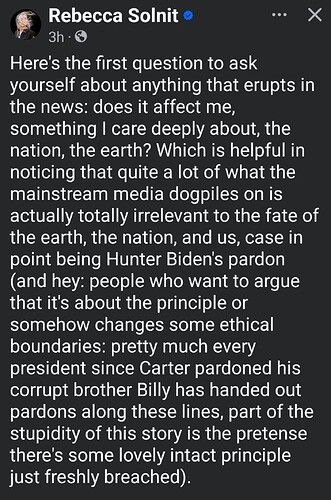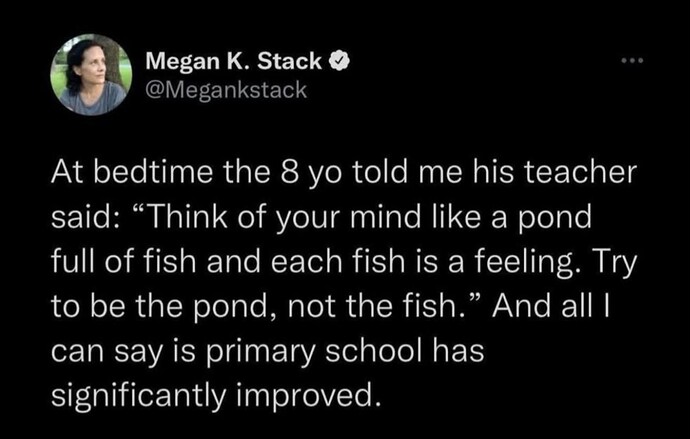Highly recommended listening:
As our centennial series continues, Timothy Snyder, history professor at Yale University and the author of On Tyranny and his latest, On Freedom (Crown, 2024), reviews the history of fascism from the early 1920s until today.
This is nothing new – the cheesy scandalmongering, the press as golden retriever eager to chase any ball the right-wing information cabal throws for it (Her Emails!) while ignoring really important stuff. Sometimes I wish there was a way to show scale for each story: the Hunter story is approximately the size of Hunter, the climate story is the size of the earth, from the bottom of the ocean to the upper atmosphere, pole to pole.
The monstrous cabinet members Trump is picking affect the whole US and international relations and the environment at every scale. Reproductive rights are the size of everyone who can get pregnant and all the social and economic consequences of having bodily self-jurisdiction or not. Violence against women is largely a hidden thing carried out on the scale of one perpetrator and one victim/survivor, but its pervasiveness affects the approximately four billion women and really, all of us, because it warps the entire social landscape.
There is so much going on. Choose where you put your attention carefully, which often means: don’t take the (click)bait.
Meanwhile I’m just coming out of a two-hour board meeting for the climate group Oil Change International, about whom you’ll be hearing lots more–my year-end fundraiser is coming. Meanwhile the parliament and citizens of South Korea are doing their brave best to overcome a coup attempt by a super-shitty president. May their valor be an example to us, and may they prevail. Eyes on the prize and the perils.
Along these lines, this article reminds me how I felt after 9/11. Playing music requires so much total concentration, for many weeks it was the only time I was able to not think about the attack.
I may need to start some really big, ambitious creative projects…
Years and years ago I read a magazine1) article about how cartoonists had elevated levels of depression, suicidal tendencies and whatnot.2)
Apparently one of the factors3) was that cartoons are a relatively small format that can be drawn relatively quick,4) so part of a suggested therapy was painting huge pictures with a very small brush.
1) One of those with more pictures than text, IIRC. So, pinch of salt and all that.
2) I also seem to remember that the article mentioned Charles Addams checking himself in after drawing the same cartoon ~200 times.
3) Other than being aware of what goes on in the world and boiling some of it down into concise, drawn comments. Which takes additional thinking about what goes on and why.
4) Possible connection/overlap with impostor syndrome?
One tactic I’ve recently stumbled upon is reading stuff in another language. My German has gotten really rusty, and so I’m reading some books in German to freshen up. I find that it takes so much concentration that for the hour or so I’m reading I can’t think of anything else. It’s quite calming.
I know escapism isn’t a long-term strategy, but we need these spaces of calm and rejuvenation if we’re going to keep up the resistance. ![]()
Doesn’t work for me for some reason…
It’s quite calming. I know escapism isn’t a long-term strategy, but we need these spaces of calm and rejuvenation if we’re going to keep up the resistance.
Yes. I agree that escapism isn’t a valuable long-term strategy for resistance, but I do think that finding “calm” is.
You’re reminding me of a favorite passage of mine in Doppelganger, Naomi Klein’s excellent, gripping account of being constantly mistaken for Naomi Wolf, and the latter’s descent from Famous Feminist (for a book called The Beauty Myth) to famous far-right conspiracy monger. In a short section labeled “Calm as Resistance,” Klein writes,
“Pattern recognition” is often how I describe the work of my life. I re- member the moment, a true click, when I realized there was a connection between the increasing precarity of work, the consolidation of ownership in key industries, and the exponential increases in marketing budgets that characterized the hollow corporate structures of the first lifestyle brands. It wasn’t a master plan that a cabal had cooked up, but there was a flow, a pattern that wove seemingly disparate trends into a logical story about a new iteration of capitalism. That was the moment I decided to write No Logo, and the feeling was so powerful that more than a quarter century later, I remember where I was sitting and what I doing when the pattern clicked into place (on the floor, on the landline speaking to a student journalist).
I wrote The Shock Doctrine in the hopes of providing a similar feeling of orientation. These were the years after the September 11 attacks had scrambled political signals and shaken the confidence of many friends and colleagues. I pursued a story, once again, of connections: this time between our moment of post-terror shock and the way other shocks have been used, over the last half century, to push policies that stripped other nations and peoples of rights, privacies, and wealth held in common.
In the torrent of disconnected facts that make up our “feeds,” the role of the researcher-analyst is plain: to try to create some sense, some ordering of events, maps of power. The most meaningful response in my writing life came from the loveliest of literary mapmakers, John Berger, when I sent him The Shock Doctrine in galleys. Many people have said they found the book enraging, but his response was very different. He wrote that, for him, the book “provokes and instills a calm.” When people and societies enter into a state of shock, they lose their identities and their footing, he observed. “Hence, calm is a form of resistance.”
I think about those words often. Calm is not a replacement for righteous rage or fury at injustice, both of which are powerful drivers for necessary change. But calm is the precondition for focus, for the capacity to prioritize. If shock induced a loss of identity, then calm is the condition under which we return to ourselves. Berger helped me to see that the search for calm is why I write: to tame the chaos in my surroundings, in my own mind, and – I hope – in the minds of my readers as well. The information is almost always distressing and, to many, shocking – but in my view, the goal should never be to put readers into a state of shock. It should be to pull them out of it.
After immersing myself in the words and actions of my doppelganger through this protracted period, I am struck that she seems to have a very different goal. Wolf routinely describes her mental state as “terrified.” She characterizes her own research into Covid vaccines as “shockingly shocking” and the public health measures she has chosen to wage war upon not as wrong, or even dangerous, but as “petrifying.”
“I don’t want to use inflated language,” she told Steve Bannon about health officials dropping basic vaccination information on people’s doorsteps. And then she went on, predicting, “They take your child away if you haven’t vaccinated him or her, like that’s the next step. Or they take you to a quarantine camp, if you can’t show your vaccination papers. I mean, that may sound a tiny bit. . . anxious or inflated…” It does sound that way. It always sounds that way. It is supposed to. The effect of conspiracy culture is the opposite of calm; it is to spread panic.
The bonus is that it might drown out any right-wing rally that happens to be nearby.
Today I got my ACLU bag in the mail. It’s large. I can probably get one of those large double-packs of Bounty in there. It’s black with large white letters on it. Made by ECO Bags, which is good. They also make the WNYC bags.
I got a dumbpain a while back, but I don’t think it can run signal.
What’s a dumbpain?
Sorry, a cell pain which is not a smartpain.
(cough) metada (cough)




